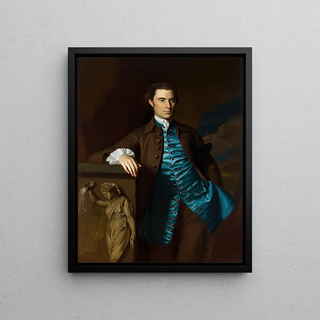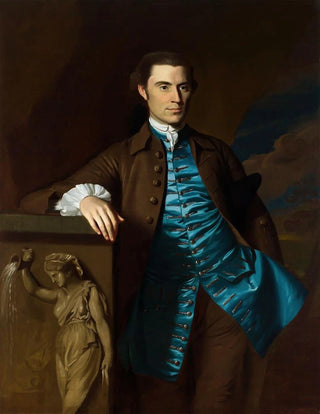Art print | Thaddeus Burr - John Singleton Copley


View from behind

Frame (optional)
In the vast panorama of art history, certain works stand out for their ability to capture the essence of an era while revealing the psychological depth of their subjects. "Thaddeus Burr - John Singleton Copley" is one of those creations that transcend the simple portrait to become a true window into the soul of 18th-century America. This painting, emblematic of Copley's style, invites us to delve into a world where light and shadow play a crucial role in visual storytelling. Through the features of Thaddeus Burr, a prominent figure of his time, the artist does not merely depict a man; he immortalizes a personality, an intellect, and a spirit of innovation that shaped the society of his era.
Style and uniqueness of the work
John Singleton Copley's style is often characterized by its striking realism and its ability to represent various textures with almost photographic precision. In "Thaddeus Burr," this approach is highlighted by the choice of colors and the finesse of details. Every element of the painting, from clothing to facial expressions, is carefully crafted, demonstrating undeniable technical mastery. Copley excels in the art of rendering light, creating contrasts that enhance the depth and dimension of the figures. Burr's posture, both relaxed and confident, evokes a certain dignity and self-assurance, characteristic of intellectual leaders of the time. This portrait is not limited to a simple representation; it tells a story, that of a man engaged in his era, and invites the viewer to reflect on his role in society.
The artist and his influence
John Singleton Copley, born in Boston in 1738, is often regarded as one of the greatest American portraitists of his time. His career, spanning several decades, is marked by a stylistic evolution that reflects the cultural and political changes of his era. Copley managed to establish himself both in America and in Europe, where he was praised for his ability to combine realism with a unique artistic sensitivity. His influence on subsequent generations of artists is undeniable, as he paved the way for a more introspective approach to portraiture.

Matte finish

View from behind

Frame (optional)
In the vast panorama of art history, certain works stand out for their ability to capture the essence of an era while revealing the psychological depth of their subjects. "Thaddeus Burr - John Singleton Copley" is one of those creations that transcend the simple portrait to become a true window into the soul of 18th-century America. This painting, emblematic of Copley's style, invites us to delve into a world where light and shadow play a crucial role in visual storytelling. Through the features of Thaddeus Burr, a prominent figure of his time, the artist does not merely depict a man; he immortalizes a personality, an intellect, and a spirit of innovation that shaped the society of his era.
Style and uniqueness of the work
John Singleton Copley's style is often characterized by its striking realism and its ability to represent various textures with almost photographic precision. In "Thaddeus Burr," this approach is highlighted by the choice of colors and the finesse of details. Every element of the painting, from clothing to facial expressions, is carefully crafted, demonstrating undeniable technical mastery. Copley excels in the art of rendering light, creating contrasts that enhance the depth and dimension of the figures. Burr's posture, both relaxed and confident, evokes a certain dignity and self-assurance, characteristic of intellectual leaders of the time. This portrait is not limited to a simple representation; it tells a story, that of a man engaged in his era, and invites the viewer to reflect on his role in society.
The artist and his influence
John Singleton Copley, born in Boston in 1738, is often regarded as one of the greatest American portraitists of his time. His career, spanning several decades, is marked by a stylistic evolution that reflects the cultural and political changes of his era. Copley managed to establish himself both in America and in Europe, where he was praised for his ability to combine realism with a unique artistic sensitivity. His influence on subsequent generations of artists is undeniable, as he paved the way for a more introspective approach to portraiture.






